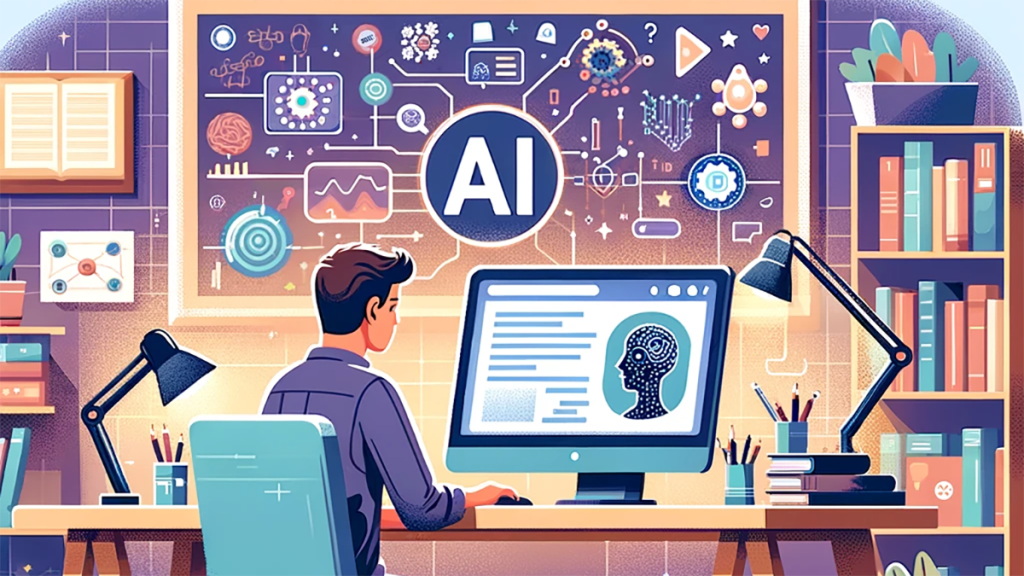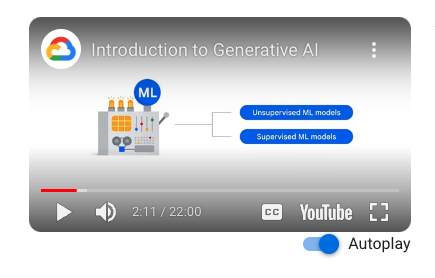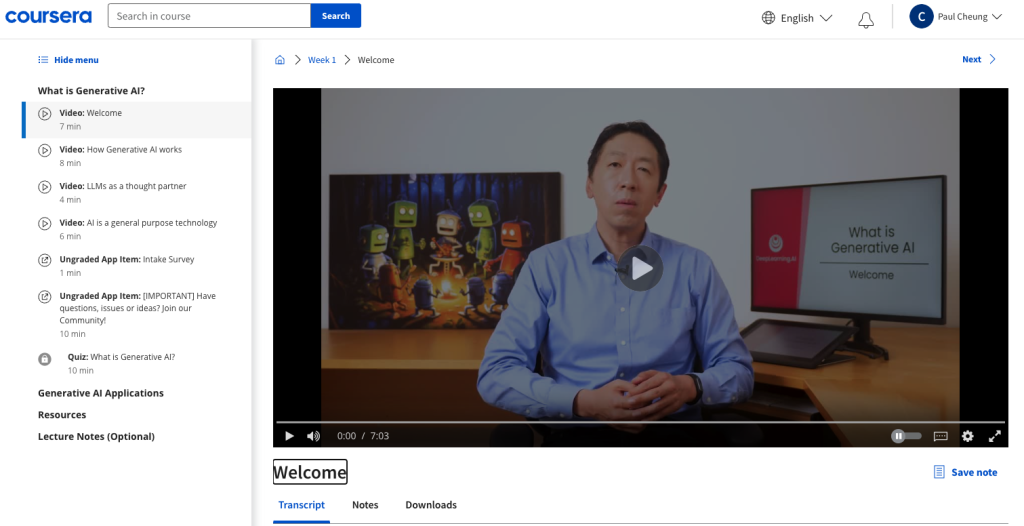
Prompt: Create an illustration of someone learning online about AI
Start on your AI journey with these three free beginner self-learning courses
Designed to transform you from a newbie to a knowledgeable enthusiast
The views expressed in this column are those of the author and do not necessarily reflect the views of the Reynolds Journalism Institute or the University of Missouri.
Paul Cheung is a RJI Columnist exploring how newsrooms and journalists with limited resources can use AI tools to improve efficiency and increase capacity in their daily development and audience operations.
Did any of you set learning a new skill as one of your top New Year’s resolutions? If that’s the case, I’ve got great news for you! Here are three online courses that can help you achieve your goal and expand your generative AI skills this year.
Linkedin Learning ‘What Is Generative AI?’
- Time: 1 hour or so

This curriculum is structured into four concise parts, each complemented by a quiz to reinforce the fundamentals. The instructional videos are succinct, typically lasting between 2 to 3 minutes, making them ideal for efficient learning.
For those with limited time, I recommend prioritizing the “Main Model” section. This segment delves into popular generative AI tools and their use in creating images from text descriptions. The course also includes a downloadable reading list for further exploration.
The third section offers quick insights into the diverse applications of generative AI across various industries, providing a glimpse into its practical uses. The final section covers ethical considerations and responsible use of AI, offering general guidelines rather than in-depth analysis. While the content is a good reminder, it doesn’t delve into groundbreaking revelations about AI ethics and responsibility.
The takeaway
This brief course provides an accessible introduction to the basics of generative AI. While it doesn’t delve into coding or complex aspects, gaining an understanding of the terminology is a key takeaway. This course is especially recommended for beginners with no prior knowledge of AI, providing a step-by-step guide to get them oriented in the field.
Google’s Introduction to Generative AI
- Time varies for each course. The introduction to Generative AI is 30 mins while Introduction to Large Language Models and Responsible AI is 8 hours each.

This is another introductory short course that offers a swift onboarding to generative AI, broken down into three short components. It begins with a 22-minute video that provides an overview of generative AI, including key topics such as the distinctions between machine learning and deep learning.
The course features a curated list of articles from prestigious sources like Google, Stanford, Harvard, McKinsey, and Deloitte. These articles cover a range of topics, from risk management in AI to its influence on creative industries. It culminates in a brief quiz consisting of five questions, designed to gauge the learners’ understanding of the material covered. Overall, this course serves as a primer on generative AI technology.
Once you finish the introductory course on Generative AI, there are two more concise courses available that delve deeper into AI topics. These courses cover the introduction to large language models and responsible AI. What stands out about these courses is their focus on Google’s perspective, utilizing Google tools to aid in developing your own Generative AI applications, and an emphasis on Google’s AI principles. Completing this trio of courses will equip you with a robust foundation in AI fundamentals, providing you with critical knowledge in the field.
The takeaway
While similar in content to LinkedIn’s course, Google’s program has a bit more technical frameworks and it also stands out with two distinctive features: a curated list of articles and a Google-issued digital badge. The curated list efficiently narrows down the vast array of AI-related articles to those deemed most essential and relevant by Google. The digital badge acts as formal recognition of your successful completion and mastery of the course quizzes, offering a valuable means to showcase your AI knowledge publicly.
Generative AI for Everyone
- Time: 6 to 10 hours

Similar to Google and Linkedin’s courses, Coursera’s “Generative AI for Everyone” course is a series of instructional videos and quizzes but delves deeper than just the fundamentals.
The course is structured into three main sections. The first part provides an overview of what generative AI is. It provides concrete examples of common use cases in AI including writing, reading, and chatting tasks for both web-UI and software-based implementations of LLMs. The instructor also provides you with some tips on prompting.
The second part of the course focuses on the stages involved in creating and managing a generative AI project. It highlights the transformation in software application development due to generative AI, contrasting it with traditional methods.
The course includes an optional coding exercise on the DeepLearning.AI platform, where learners can practice running code and observing outputs, such as sentiment analysis of texts. The platform’s interface facilitates learning with code on one side and instructional videos on the other, guiding users through each step. It also goes deeper into advanced AI technology beyond prompting such as when it is beneficial to apply more complex methods, such as retrieval augmented generation (RAG), a technique for enhancing the accuracy and reliability of generative AI models with facts from external sources, to make the AI smarter and more tailored to specific needs. Later in the section, it highlights the cost implications of using cloud-based AI systems in software development.
The final part examines how generative AI can impact businesses and the ethical considerations that come with it. It emphasizes analyzing current work processes to identify new opportunities where generative AI can enhance efficiency, productivity, and overall value. It also notes that AI tends to automate specific tasks within jobs rather than replacing entire job roles. When assessing tasks for AI integration, the key factors to consider are technical feasibility and the potential business value. Furthermore, it also touches on the principles of responsible AI use, which include fairness, transparency, privacy, security, and ethical usage. It stresses the importance of learning strategies to ensure that AI development and deployment are both ethical and socially responsible.
The takeaway
What stands out in this course is how instructor Andrew Ng simplifies complex technical concepts with clear, relatable examples. For instance, he demonstrates how chat systems are trained to follow instructions, providing insights into the approaches programmers use behind these systems. This method of teaching is incredibly beneficial for those who might need to collaborate with programmers in developing AI products or work with vendors, offering a practical understanding without delving into the specifics of coding.
In summary, if you’re short on time and just want the basics, the LinkedIn course is the ideal choice. If having a badge of completion from big tech matters to you, then opt for Google’s course. For journalists seeking to grasp a solid understanding of the potential and current limitations of AI, without needing coding skills, Coursera’s “Generative AI for Everyone” is my pick of choice.

Comments